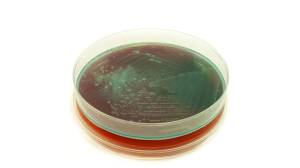The symptoms of cystic fibrosis are as varied as the disease presents itself.
In the first few days of life about 20% of newborn babies present with an ileus or intestinal obstruction. Another not too uncommon form of presentation is a volvulus (a twisted bowel). The child may catch an abnormally persistent cold that continues with wheezing and coughing. CF patients do not tolerate viral or bacterial respiratory tract infections well.
The reason for this is that their mucous membranes are already pre-damaged and infection makes this worse and more persistent. Stools are greasy, bulky and often there are visible droplets af fat in the stool. This is due to the pancreatic enzyme deficiency and the lack of normal digestive juice production in the glands of the intestinal wall.
Despite good food intake the child is not thriving and lacks normal growth. Acid bile reflux leads to chronic esophageal reflux (see “acid reflux or GERD)”. In summer with more sweating children may loose a lot of salt through the skin, which a parent may pick up accidentally through a salty taste when kissing the child. A harmless stomach flu in one child may turn into a major electrolyte imbalance problem in the sibling who has CF, possibly even requiring a brief hospitalization for intravenous fluid replacement.
With regard to the lungs there is a chronic recurrent cough due to problems with clearing out tenacious bronchial secretions. There are many recurrent bacterial and viral airway infections including a tendency for each episode to turn into pneumonia. Problem bacteria such as Pseudomonas aeruginosa or Staphylococcus aureus are isolated from bronchial secretions (=sputum) at a young age in childhood, which is normally not seen in other children. There is respiratory distress with chest infections where the chest walls between the ribs show in-drawing.
The physician hears wheezes and crackles. After a few years clubbing (thanks to www.meddean.luc.edu for this image) of the fingers develops. With advance lung disease CF patients look cyanosed (blue skin color). Swelling of the saliva producing glands (submaxillar and parotid glands) may mimic the look of a mumps infection, but in the case of a CF patient it is due to blocking of the saliva producing gland ducts. The liver may feel enlarged to the physician and the abdomen is bloated (portal hypertension from liver cirrhosis and digestive problems). There may be abnormalities of the curvature of the spine (scoliosis and kyphosis) due to a lack of vitamin D absorption and a rickets-like skeletal deformity.
Other symptoms are recurrent rectal prolapse, nasal polyps and sinusitis.
References:
1. Noble: Textbook of Primary Care Medicine, 3rd ed., Copyright © 2001 Mosby, Inc.
2. National Asthma Education and Prevention Program. Expert Panel Report II. National Heart, Lung and Blood Institute, 1997.
3. Rakel: Conn’s Current Therapy 2002, 54th ed., Copyright © 2002 W. B. Saunders Company
4. Murray & Nadel: Textbook of Respiratory Medicine, 3rd ed., Copyright © 2000 W. B. Saunders Company
5. Behrman: Nelson Textbook of Pediatrics, 16th ed., Copyright © 2000 W. B. Saunders Company
6. Merck Manual: Cystic Fibrosis (thanks to www.merckmanuals.com for this link)
7. Goldman: Cecil Textbook of Medicine, 21st ed., Copyright © 2000 W. B. Saunders Company
8. Ferri: Ferri’s Clinical Advisor: Instant Diagnosis and Treatment, 2004 ed., Copyright © 2004 Mosby, Inc.
9. Rakel: Conn’s Current Therapy 2004, 56th ed., Copyright © 2004 Elsevier







